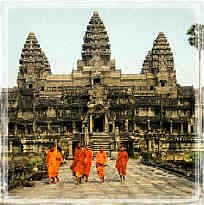World Bike Tour - Angkor Wat
 I am planning to save up some money and leave to take part in World Bike Tour in Angkor Wat on 16th and 17th Dec. Perhaps I see whether I may have chance to travel to neighbouring countries like Vietnam, Laos or Burma. See the interesting information on the World bike tour to advocate the cause to protect the child suffering, child labour, child smuggling and child paeodilipic.
I am planning to save up some money and leave to take part in World Bike Tour in Angkor Wat on 16th and 17th Dec. Perhaps I see whether I may have chance to travel to neighbouring countries like Vietnam, Laos or Burma. See the interesting information on the World bike tour to advocate the cause to protect the child suffering, child labour, child smuggling and child paeodilipic.Bikers from all over the world will gather to experience the stunning
Angkor Wat ancient temple ruins while supporting Village Focus
International (www.villagefocus. org), a non-governmental organization
working in Southeast Asia. I hope your group's members will consider
attending. The participant who raises the most sponsorships will win
a round-trip ticket to the event.
The 80 km course will give participants a once-in-a-lifetime
opportunity to see the temples as they once were, free of the traffic
of the 750,000 tourists who now visit annually. Participants can
expect to be joined only by the locals living in the forests around
the temples, who will be cheering the bikers along.
Village Focus is an innovative organization that is making a
remarkable impact on the lives of thousands of people in Southeast
Asia by empowering local leaders who wish to create positive change in
their communities. Target issues include: strengthening civil society
and human rights, defending land rights for indigenous people,
protecting vulnerable children against trafficking and pedophilia, and
promoting fair trade.
 Angkor Wat (or Angkor Vat) is a temple at Angkor, Cambodia, built for king Suryavarman II in the early 12th century as his state temple and capital city. The largest and best-preserved temple at the site, it is the only one to have remained a significant religious centre—first Hindu, then Buddhist—since its foundation. The temple is the epitome of the high classical style of Khmer architecture. It has become a symbol of Cambodia, appearing on its national flag, and it is the country's prime attraction for visitors. Angkor Wat combines two basic plans of Khmer temple architecture: the temple mountain and the later galleried temples. It is designed to represent Mount Meru, home of the gods in Hindu mythology: within a moat and an outer wall 3.6 km (2.2 miles) long are three rectangular galleries, each raised above the next. At the centre of the temple stands a quincunx of towers. Unlike most Angkorian temples, Angkor Wat is orientated to the west; scholars are divided as to the significance of this. As well as for the grandeur and harmony of the architecture, the temple is admired for its extensive bas-reliefs and for the numerous devatas adorning its walls.
Angkor Wat (or Angkor Vat) is a temple at Angkor, Cambodia, built for king Suryavarman II in the early 12th century as his state temple and capital city. The largest and best-preserved temple at the site, it is the only one to have remained a significant religious centre—first Hindu, then Buddhist—since its foundation. The temple is the epitome of the high classical style of Khmer architecture. It has become a symbol of Cambodia, appearing on its national flag, and it is the country's prime attraction for visitors. Angkor Wat combines two basic plans of Khmer temple architecture: the temple mountain and the later galleried temples. It is designed to represent Mount Meru, home of the gods in Hindu mythology: within a moat and an outer wall 3.6 km (2.2 miles) long are three rectangular galleries, each raised above the next. At the centre of the temple stands a quincunx of towers. Unlike most Angkorian temples, Angkor Wat is orientated to the west; scholars are divided as to the significance of this. As well as for the grandeur and harmony of the architecture, the temple is admired for its extensive bas-reliefs and for the numerous devatas adorning its walls.


1 Comments:
Aiyoh so ulu and wild. I would rather go to a resort hee.
Post a Comment
<< Home